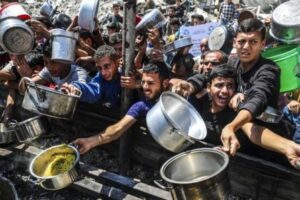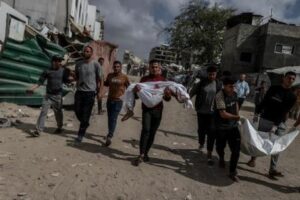Daniel Libreros Caicedo, a lecturer at the Universidad Nacional de Colombia and member of the steering committee of the Movimiento Ecosocialista (Ecosocialist Movement) analyzes the ongoing mass mobilization in Colombia. On November 21 (21N), millions participated in the country’s largest strike and mass demonstrations ever. This article appeared first in Correspondencia de Prensa. Translation by Lance Selfa.
On November 21 (21N), Colombia witnessed a social explosion unprecedented in the country’s history since the mid-20th century. On that day, the National Strike Command, made up of main trade union federations (Central Unitaria de Trabajadores—Confederación General de Trabajadores—Confederación de Trabajadores de Colombia) and organizations of students, peasants, indigenous people, Afro-descendants, pensioners and environmentalists who in recent years had led the resistance to these government policies, called a march to protest the government’s announcement of regressive economic reforms. The union federation planned, as in many previous years, pro-forma year-end marches to set the stage for negotiations on the minimum wage with the government. Low levels of organization (unions represent only about 4 percent of the workforce), owing to anti-labor legislation and the criminalization of social protest, put a limit on the level of social mobilization.1 Internally, this fragility in the level of mobilization led to isolation of the movement and resulted in top-down and closed organization that required agreements “from above” between the union leaderships, the left-wing parties and the non-party social movements. In addition, their plans of action were usually narrowed to take up only union-specific demands.
Everything seemed to point to a business-as-usual march. However, in the weeks leading up to 21N, the social unrest that had emerged in neighborhoods, universities, among informal workers and the unemployed, began to focus on that day. International news helped, too. At about the same time, the Ecuadorian indigenous movement defeated the International Monetary Fund’s attempt to impose an austerity plan. And in Chile—the poster-child of Latin American neoliberalism and darling of neoliberal technocrats—a gigantic social explosion erupted. It is still shaking the government of Sebastián Piñera. The “contagion” from other countries inspired the downtrodden in one of the most unequal countries in the region. The announcement of greater sacrifice—to an already increasingly impoverished population—provoked outrage in a population already fed up with the impunity granted perpetrators of daily murders of social movement leaders, the corruption and looting of public resources by politicians and big business, and a justice system that lets them all off scot-free.
For this reason, 21N ended up becoming a massive mobilization that swept in broad layers of the population who took to the streets to protest against the multiple forms of the oppression produced by the established order and the cynicism of its political representatives. For the first time in decades, the streets of the country’s major cities witnessed a parade of millions of people defying government threats, curfews, and targeted “preventive” raids prior to arrest protest leaders. In other words, the people stood up to well-known threats of state terror.
At night, in neighborhoods throughout the country, the 21N mobilizations had backing of the cacelorazos (pot-banging protests). These underscored the widespread support for and legitimacy of the strike. In the subsequent days, marches and cacelorazos continued in streets, neighborhoods and parks, accompanied by musical and theater groups. A spectacle of collective euphoria and street art.
On Sunday, December 8, some 300,000 people came out to the “strike concert” in various places around downtown Bogotá. Youth orchestras performed to show their solidarity. When the organizers applied for permits for artistic events, the mayor’s office offered them the Simón Bolívar Park, a site that accommodates thousands of people for these types of events. The organizers rejected the offer and set up risers in the streets. This reflected a desire to prolong the enjoyment of public space, they argued, affirming the popular feeling of taking to the streets and leaving behind the fear that for decades has condemned us to ostracism. It was a sentiment you overheard in daily conversations: “this country is not the same after November 21.”
The government’s failed “internal security” policy
Historically, the main justification for the elites to outlaw social resistance was to accuse it of collaboration with the guerrillas who have been fighting a civil war since the middle of the last century. Any protest from any sector of the population was characterized as being in league with the guerrillas. This served as a pretext for the government to outlaw civil liberties, to arrest protest leaders and to prosecute them.
The ongoing peace negotiations with the FARC (Revolutionary Armed Forces of Colombia) undercut this argument and opened new possibilities for the popular movement. This negotiation did not propose a transition to democratic reform nor meet the aspirations of democratic parties, organizations and personalities that had supported the proposal for a political solution to the conflict for decades. Still, a right-wing political alliance led by former president Álvaro Uribe, including the Conservative Party, the majority of the Catholic Church and the preachers of the evangelical churches, defeated the negotiated settlement by referendum in October 2016. This forced a new negotiation between the parties that included the intransigent Uribe, which resulted in a much-reduced agreement that was whittled away even more in Congress. The final version of these agreements contemplated a system of justice, truth and reparations under a Special Justice for Peace (JEP), in charge of “transitional justice,” and a Truth Commission. In the case of the JEP, the treatment of those who had financed the war (businessmen and large landowners) was so lax that they were allowed to decide whether to come forward to face justice. Likewise, a legal technicality of “refusing state action” opened up the possibility of amnesty by not recognizing the role of “chain of command” in the case of human rights violations by members of the armed forces.
Nor did the economic agenda point to structural reforms. Given that the FARC was a rural guerrilla force with a peasant tradition, the issue of land was central to the negotiations. However, the agreement did not challenge the creation of enormous latifundias (large estates) from peasant land stolen during wartime or bought by means of money laundering.2 The agreement ended up legalizing the latifundistas’ ownership of 7 million hectares in FARC territory, while creating a fund of 3 million hectares for distribution to poor peasants nationwide. So far these provisions have remained dead letters. An additional point in the agreement was the state’s commitment to invest in marginalized and conflict-ridden regions, about which the government has reneged under the pretext of the current fiscal crisis. As if that were not enough, 170 demobilized FARC members have been assassinated since they laid down their arms. The most recent of these were actually killed in camps where they reported in compliance with the agreements.
In spite of these limitations in the design and implementation of the agreements, the far right has been trying to limit them even more. President Iván Duque’s Democratic Center party presented a series of objections to the JEP that sought to grant amnesty to human rights violators over Congress’ objection and to nullify reparations for victims in 16 parliamentary constituencies that were agreed to in the negotiations.
Regarding the maintenance of “public order,” the current government has been implementing a policy crafted under the old arguments around an “internal enemy.” It appointed General Nicacio Martínez to be in charge. The Attorney General’s Office has identified Martínez as responsible for extrajudicial executions (which the press euphemistically calls “false positives”) in the Caribbean region (Departments of Guajira and Cesar) during 2006 when he was the second-in-command and chief of staff of the brigade located in that region.3
As soon as he assumed command, Martínez ordered rules of engagement that could lead to extrajudicial executions, a policy that The New York Times revealed after obtaining information from officers4 who disclosed murders and “suspicious” arrests. In the midst of these accusations was the murder of former FARC guerrilla Dimar Torres in the municipality of Convención, Catatumbo region, located in the northeast of the country. Unarmed, he was arrested and killed by active-duty military. This murder stood out because it was well publicized and denounced by the townspeople. This forced General Diego Luis Villegas, commander of the special forces of that region, to ask for public forgiveness—a gesture he repeated before the Congressional Peace Commission.
Subsequently, at the beginning of November and in the middle of a parliamentary debate, the public learned of the tragic result of a late-August bombing of so-called FARC “dissidents” at in San Vicente del Caguán, department of Caquetá, in which 18 children died. In this debate it became clear that, prior to the bombing, the army was aware of the presence of minors on the ground and that the brigade command had been officially informed by the municipal official. It was also clear that the army had been hiding information about what had happened for months. The debate led to the resignation of the then-defense minister Guillermo Botero.5
These tensions within the army and between the ruling parliamentary factions demonstrate that the elite is split between those grouped around Uribe, who want to hold on to the policy of “internal security,” and those who supported former president Manuel Santos in the political negotiation with the FARC in Havana. They believe that the army can win legitimacy if it accepts a post-conflict environment. For this reason, they formed a political bloc called “Defenders of Peace” to demand the implementation of the agreements in their final version. All of the non-Uribe affiliated parties, including the left and campaigning human rights movements, joined in. They played an active role in forming alliances in the October 27 regional elections in which the Democratic Center lost in all of the major cities.
Beyond these inter-elite contradictions, the strain on the government as it attempts to defend its militaristic policy is evident. The popular rejection of the ongoing assassinations of social and environmental leaders and members of ethnic communities in peripheral regions is increasingly resonating in the cities. The case of the children killed in the Caquetá bombing produced widespread indignation that found a massive echo in the November 21 mobilization.
In the development of the strike itself, the population has had to face another form of state terror: the riot squad (ESMAD), a police force trained to confront protest marches. Created in 2007 during the second Uribe administration, it has been responsible for several deaths during the protests as well as arrests and beatings. But in the midst of a social explosion like the current one, this repression generated even more resistance. On November 23 in downtown Bogotá, a member of that riot squad fired a pellet gun at close range, badly wounding an 18-year-old high school student, Dilan Cruz. Dilan died a few days later in a city hospital and became a symbol of the resistance. On December 11, members of the same squad, riding in an unmarked car, tried to kidnap two students at a rally in front of the National University. A citizen, hearing the students’ shouts, got into his vehicle and followed the unmarked car. He forced it to stop in front of a protest march and outed the undercover cops, to the astonishment of bystanders. Many demonstrators have faced repression in the courts and others, as in Chile, have lost their eyesight from the riot police’s deliberate targeting of rubber bullets at eye-level. Because of these despicable events, one of the main and unifying demands of the strike—as well as of the democratic movement as a whole—is the dissolution of the ESMAD, which on this occasion could not stop the avalanche of street protest.
The economics of the crisis of neoliberalism in the periphery
The current international economic crisis exposed the fragility of the extractivist financial model in Latin America. The sharp fall in international commodity prices during the period 2013-2017 produced trade and fiscal deficits throughout the region, swelling the public and private debt. Under these conditions, and as occurs in periods of decline in peripheral economies, foreign direct investment (FDI) fell. In the case of FDI, with investments in extractive sectors becoming less profitable and with investors seeing their “risk premium” increase, capital fled the region. Thus began the vicious circle, where reduced foreign investment devalued local currency and increased debt, which brought on “structural adjustment” plans that further contracted demand. But a population that is fed up with this constant reduction of their living standards rose up to reject it. The mobilizations in Ecuador and Chile were explicit about this. In Colombia, on November 21, the population showed that it, too, was fed up with neoliberal austerity.
A few weeks before the strike, the Duque government proposed to Congress a tax reform in line with many others enacted in the neoliberal era since the early 1990s. It would increase tax exemptions for big business while shifting most of the tax burden to the middle class and poor. This, in a country that since 2000, has seen 13 tax “reforms” like this—one every year and a half—and that already has one of the most unequal distributions of wealth in the region.
As if that wasn’t enough, the government proposed a “labor law reform” that would make work even more precarious, including converting salaried employees to hourly employees; changes to the pension laws to benefit private pension funds; and, at the recommendation of the Organization for Economic Cooperation and Development (OECD), the creation of a sovereign wealth fund to compete in the international capital market.
This government economic package flowed directly from transnational capital’s demands to stabilize the economy in the face of the drop in the price of oil, the country’s main export commodity.
Colombia has a current account deficit of more than 4 percent of GDP, increasing sharply since 2013 due to the collapse in oil prices and capital flight. In the period of 2013-2017, revenue from oil exports fell by 60.4 percent and FDI in the petroleum sector fell by 41.3 percent.6 Despite the partial recovery of international oil prices in recent years, this deficit continues to grow,7 as does the reduction in FDI,8 which has precipitated the flight of short-term capital, illustrated in the decline of portfolio investments.9
In the midst of this economic decline, currency devaluation reached one of the highest levels in the international average of currencies,10 swelling the foreign debt. The public debt already approaches 51 percent of GDP, which is particularly serious in a country whose IMF-imposed budget legislation places paying interest on the debt over all other priorities.11
Under these aspects of neoliberal domination, austerity becomes “inevitable.” While street demonstrations demand a more just society, the president and the majority in Congress keep trying to pass legislation demanded by transnational capital. This underscores the divide between the population and national institutions, proving just how limited is the “representative democracy” created in the image of neoliberalism, supported by corrupt politicians, business lobbies and secret negotiations. What we are witnessing in Colombia and in Latin America in general is not only the crisis of neoliberalism as an economic model based on dispossession, but also the crisis of its forms of political representation.
The challenges posed by the new political situation
Since 21N, the country has seen the emergence of a pluralistic movement involving workers, poor people in urban neighborhoods, and the middle classes facing rising taxes and high interest rates in the cities. Within this social convergence, the role of the youth movements demanding their rights and rejecting militarism must be highlighted.
These youth expressions have antecedents in earlier university resistance movements. In fact, in 2011, the National Student Board managed, through a broad protest, to defeat the Santos government’s proposal for “university reform.” And last year, another similar movement forced the government to spend more on education than it had initially proposed. Now, the youth mobilization is much broader. It includes young people who cannot afford universities, or of those who, having obtained a professional degree, cannot find employment.12 It includes private universities students weighted down by debt. The same goes for those in technical institutes who, before finishing their studies, know that they have only precarious employment waiting for them after graduation. It includes those who, because of poverty, cannot finish high school, or buy health care, nor achieve a minimum level of well-being.
As has happened in other parts of the world with similar social movements, social media plays a key role in the spontaneous mobilization of young people. Outrage at the “the consequences of neoliberalism” without knowing its causes,13 mobilizes them. The youth movement rejects institutions and the dominant parties. At the same time, they do not feel represented in the left-wing parties or in the traditional popular organizations. This movement rejects top-down decision making and closed leaderships, calling for democratizing decisions. This strengthens its actions. At the same time, the movement’s politics expresses a broad ideological pluralism in the midst of the depoliticized environment that neoliberalism created. This represents a political weakness.
Within this diversity of ideology, two issues, highlighting the civilizational crisis of contemporary capitalism, stand out: the destruction of nature and the preservation of patriarchal society, challenged most forcefully by young women in the universities and professions.
The wide-ranging social movement that fed the 21N street protests doesn’t correlate to forces that demand changes to government institutions, such as the resignation of the president or the calling of a constituent assembly, as in the case of Chile. However, in its short existence it has:
- Defeated state terror that for decades outlawed the actions of popular organizations by treating them as extensions of the war against the guerrillas;
- Brought social resistance from the countryside into the cities, both in the way that it erupted in the urban areas, and in its demands;
- Strengthened a movement in defense of human rights that opposes the assassination of social leaders and that demands a democratic policy guaranteeing the definitive end of the armed conflict;
- Placed social inequality, as the national expression of an international crisis of neoliberalism, at the center of the national discussion.
The National Strike Command that convened the 21N demonstration continues a dialogue with the government. The swathes of the population who mobilize spontaneously or who belong to a diversity of social organizations stand outside of this dialogue. But they are too politically disparate and lack the capacity to pose themselves as an alternative political option.
For the moment, they coordinate in neighborhood assemblies, a geographic form of direct democracy that opposes “urban extractivism,” or neoliberal-fueled dispossession in cities.14c These neighborhood assemblies can become higher expressions of democracy if they manage to come together and join with the national movements resisting government policies. This speculation obviously depends on the strike’s staying power into the coming year—which, under the current circumstances, seems possible—and on its response to challenges posed to the movement by the confrontation with the government. A political alternative will continue to be debated, although now in a new context. For those of us who are convinced of the necessity of an anti-capitalist strategy, there is an urgent need for organization.
Notes
1 The CUT’s human rights department has documented the murders of 3,000 unions activists since the federation was founded in the mid-1980s.
2 The levels of concentration of ownership of land are very high. One percent of rural landowners own 60 percent of cultivable land while 2.5 million families live on the rest.
3 During Álvaro Uribe’s second term, in 2008, the country learned that the armed forces had killed unarmed civilians while calling them combatants. See “El jefe del Ejército de Colombia dirigió una brigada acusada de matar a civiles”, El País”, Madrid, 5-06-2019, here. These so-called “false positives” were one of the most prominent military scandals of Uribe’s first term. To obtain bonuses and leave time, according to provisions in Defense Ministry manuals (copied from the U.S. army), members of the armed forces kidnapped poor youths on the edges of the cities, some of them disabled. They took these youths to the conflict zones, dressed them in guerrilla uniforms and then ejecuted them—all to win benefits. Social and human rights organizations estimate that as many as 10,000 young people died this way.
4 See False positive 2.0? The New York Times’ complaint against the national army.
5 Botero resigned on the eve of a congressional vote to censure him. He would have been the first top government minister to be forced to resign because of a motion of censure. See “Renuncia Ministro de Defensa”, El Tiempo, 5 de noviembre del 2019, en https://www.eltiempo.com/justicia/conflicto-y-narcotrafico/renuncia-ministro-de-la-defensa-guillermo-botero-431146.
6 See Marco Fiscal de Mediano Plazo-2018, p.127 y ff.
7 Colombia’s trade deficit more than doubled last August (2019), reaching $1.4 billion, up from about $700 million registered in August, 2018. El Tiempo, 18 de octubre del 2019, en https://www.eltiempo.com/economia/sectores/deficit-de-la-balanza-comercial-de-colombia-en-agosto-del-2019-424464
8 According to official statistics, FDI fell 14.1 percent in 2018, from $10.1 billion in 2017 to $8.7 billion in 2018.
9 These portfolio investments continue to drop. During 2018, they fell by 53.4 percent, signaling rampant capital flight. The country is deficit if we take into account the differential between income from foreign investment and profits and payments of dividends that for many years appeared as “factor income” in the balance of payments. The deficit reached about $11 billion in 2018.
10 In 2014, one U.S. dollar bought 1,800 Colombian pesos. At the end of 2017, that exchanged reached 3,000 pesos, and today approaches 3,500. More evidence for capital flight.
11 This refers to the “primary surplus” that is not only required of public budgets, but also in development plans and public policy.
12 In the Universidad Nacional, the most important public university in the country, about 60,000 high school graduates are qualified for admission every six months. Of these, only about 7,000 enroll. Youth unemployment is around 22 percent, far below youth unemployment around the globe. We have to treat these statistics with caution.
13 These have been called movements of an “emerging citizenry” that want to come out of the shadows that neoliberalism has driven them to.
14 The spatial reordering of cities at the hands of the real estate and finance industries in search of profits displaces the urban poor in the same way that the hydrocarbon and mining industries displace rural people. This is why the process has been described as “urban extractivism.”
Paul D'Amato is the author of The Meaning of Marxism and was the editor of the International Socialist Review. He is the author of numerous articles on a wide array of topics.



